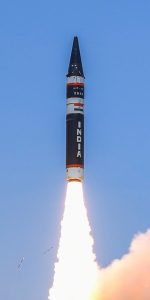Agni-P Missile:

The Defence Research and Development Organisation (DRDO) successfully test-fired the new generation nuclear-capable ballistic missile ‘Agni Prime’.
- This is the second test of the missile, the first test took place in June 2021.
- The Agni-P missile aims to further strengthen India’s credible deterrence capabilities.
- Agni-P is a two-stage canisterised solid propellant missile with dual redundant navigation and guidance system.
- It has been termed as a new generation advanced variant of Agni class of missiles with improved parameters, including manoeuvring and accuracy.
- Canisterisation of missiles reduces the time required to launch the missile while improving the storage and ease of handling.
- The surface-to-surface ballistic missile has a range of 1,000 to 2,000 km.
Agni Class of Missiles:
- Agni class of missiles are the mainstay of India’s nuclear launch capability, which also includes the Prithvi short-range ballistic missiles, submarine launched ballistic missiles and fighter aircraft.
- Agni-V, an Inter-Continental Ballistic Missile (ICBM) with a range of over 5,000 km, had been tested several times and validated for induction.
- The Agni-P and Agni-5 ballistic missiles trace their origins back to the Integrated Guided Missile Development Programme (IGMDP), which was spearheaded by former DRDO chief and ex-Indian president Dr APJ Abdul Kalam in the early 1980s.
Other Ranges of Agni Missiles:
- Agni I: Range of 700-800 km.
- Agni II: Range more than 2000 km.
- Agni III: Range of more than 2,500 Km
- Agni IV: Range is more than 3,500 km and can fire from a road mobile launcher.
- Agni-V: The longest of the Agni series, an Inter-Continental Ballistic Missile (ICBM) with a range of over 5,000 km.




